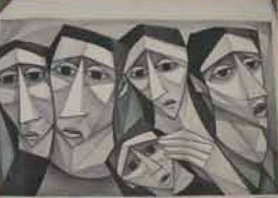The bodies are pressed against one another, a mass of form and texture, scarcely a breath of air between them. They are every hue and shape and size, but united in common purpose, arms outstretched to embrace the sun.
They are every hue and shape and size, but united in common purpose, arms outstretched to embrace the sun.
The scene may give the impression of a crowded beach or a peace march, but this is actually a journey into the artwork of acclaimed Canadian artist Gerald Trottier. However you choose to interpret it, there is no denying that the strong lines and bold colours favoured by Trottier in many of his works portray the depth of a man passionate about his craft.
The Buchanan Library at Lethbridge College recently acquired a Trottier work entitled, “Refugees,” a lithograph of nuns portrayed in muted tones and sharp angles.
The piece was donated to the library last September by Trottier’s widow Irma, now 84, who felt it represented some of his best work. The choice of Lethbridge College as a recipient for the generous gift came through a remarkable coincidence.
In the 1960s, Donald Buchanan (for whom the College library is named) was assistant director at the National Gallery in Ottawa where he became acquainted with Gerald Trottier. Buchanan was a talented photographer who travelled extensively in Europe, chronicling his journeys on film. He was also a connoisseur of fine wines and, while in France, discovered vineyards where he could purchase cases of wine and have them shipped home to Ottawa.
Irma shares the story of the developing friendship between Buchanan and Trottier. “When the cases would arrive, Donald would invite Gerald to his abode to sample this wine and talk about art and view the photographs he had taken while in Europe. As a result, they exchanged works.”
Buchanan subsequently submitted one of Trottier’s pieces, “The Field” (1959), to Lethbridge College. After Trottier’s death in 2004, his family began the process of archiving his life’s work. One of the family members wrote to the college to request a photo reprint of “The Field” and was taken aback when the reply came from the Buchanan Library.
“I inquired whether that was the same Donald Buchanan who had been employed at the National Gallery,” says Irma. “Of course it was, and that is when I asked if they would accept three of Donald’s photographs to go along with Gerald’s oeuvre (work).”
She offered the “Refugees” (1953), along with a sketch entitled “Francis Bacon” to complement the sole piece already in the library.
Irma visited Lethbridge College and the Buchanan Library for the first time last year; she says she was “very impressed” with the exhibit.
“It was very well housed and in good condition. I thought it was great. . . I was amazed to see that A.Y. Jackson had spent some time in the area.”
Irma feels the display will be an asset to the Lethbridge College collection, and would have met with her late husband’s approval.
“I think he would have been very pleased, especially knowing that it was housed in the Don Buchanan library. He and Don were very good friends.”
For the first time in 25 years, Lethbridge College put the Buchanan Gift on public display during its Homecoming ’08 celebration last May. The Buchanan Gift was given to Lethbridge College in 1963 by Donald and Hugh Buchanan as a tribute to their parents, the Hon. W. A. Buchanan and Alma Buchanan.
Normally kept vaulted for protection, the entire collection will be available for viewing 1-5 p.m. Saturday, May 17 in the Buchanan Library on campus.
Though not an artist herself, Irma claims a love of art and culture and a “penchant for history and philosophy.”
“To be present, to be near someone who created a work of art, to me is a true revelation,” she says. “When I marveled at a work of Gerald’s, he always reminded me that I, too, was creative. When he saw me kneading the bread and saw the end result, he called it a work of art.
“I always had a great love of the beauty around me. A peaceful joy and tranquility surrounds me when I’m viewing art and architecture. As a child, I had an awareness of the hand-made crafts in our home. Both my parents and my grandparents were very gifted people.”
Irma Tremblay Trottier was one of six children reared in the pastoral setting of Grand Calumet Island, Que. The offspring of a prosperous farmer and a teacher, the Tremblay clan attended primary school in the isolated community on the Ottawa River.
“After that, we had to leave home and attend boarding school. I was sent to Montebello, in Quebec. Others in the family chose to go to Montreal and one went to Ottawa. What joyous memories I have of our return to the family for the holiday season.”
After high school, Irma relocated to Ottawa to further her education and it was there that she first encountered Gerald Trottier. “We met here in Ottawa while he was attending the Ottawa Technical School. I was at a business school in 1943; we were both 18.”
Gerald served briefly in the armed forces, after which he was awarded a post-discharge grant that he used to further his study of art. The couple married in 1949 and, in 1953, Gerald received a scholarship to study in Europe. He went to France to learn lithography and participated in a three-day pilgrimage from Notre Dame to Chartres Cathedral. This journey would come to have a significant influence on his work.
The Trottiers had three children: Denise, Francois and Marc. In 1962, Gerald received a Canada Council fellowship and the family returned to Grand Calumet Island. With the help of Irma’s father, Gerald was able to build a studio in the farmhouse the couple bought.
After some time, however, the two became concerned about the lack of educational and cultural opportunities for the children, and missed the direct involvement with the arts community in the city.
“There was no music, no libraries. You don’t realize that [you’ll miss it until] you’re away from it. We just couldn’t stay there.”
Their chance to return to a more metropolitan environment came in 1965, when Gerald was invited to study at the University of Western Ontario in London.
In the years following, Gerald re-established his connection with the artistic community and forged a reputation as a creative talent. Though he always worked full time at “regular” jobs (most notably, a total of 17 years as a design director for the CBC), Trottier was a prolific artist whose work was showcased in countless exhibitions here and abroad.
He accepted many important commissions, including six Canadian postage stamps, a ceremonial mace for York University in Toronto, a cover for Canadian Art Magazine and a phenomenal, 10’ x 168’ mosaic mural for Carleton University in Ottawa.
Trottier was also well known for creating religious artwork and liturgical appointments for numerous churches throughout Quebec and Ontario. One project, a life-sized “corpus” (image of Christ on a crucifix) was commissioned for Blessed Sacrament Church in Ottawa, and later became part of an exhibition of religious art.
Since her husband’s death, Irma continues to promote his work by providing information and assistance to exhibitors and biographical writers. One of the most comprehensive publications on his work is a catalogue by Sandra Dyck, Carleton University Art Gallery curator, entitled, “A Pilgrim’s Progress: The Life and Art of Gerald Trottier.”
Irma acknowledges the assistance of her extended family.
With the help of my family, I have established the archives of all of Gerald’s life’s work. I don’t do this alone,” she says, “I’m going to be 84 this year so it’s getting a little harder to get around.”
Son Marc Trottier and his wife Wendy Vance have played an important role in the projects as well.
“Both are honour graduates of the Theory and History of Fine Art program from the University of Ottawa,” Irma says. “They have contributed to organizing the archives of Gerald’s work. Marc has lectured on his father’s work at the National Gallery.”
Irma contacts Canadian galleries to inquire as to whether they would be interested in acquiring more of his work. All, of course, are pleased to be the beneficiaries of the Trottier pieces. His work is included among the collections of the National Gallery, Carleton University, the University of Western Ontario, Memorial University in St. John’s, the Department of Foreign Affairs, and galleries in Toronto, Ottawa, Hamilton, Winnipeg and London, Ont., among others.
When asked about the personal satisfaction of carrying on the work, Irma says, “My reward is to have my grandchildren made aware of their grandfather’s talents and recognition in the art world. He contributed so much in the many facets of the art world.”
As for her own legacy to her children and grandchildren, “I hope people would remember me as a devoted wife…a loving wife to my husband and a loving mother to my children.”


